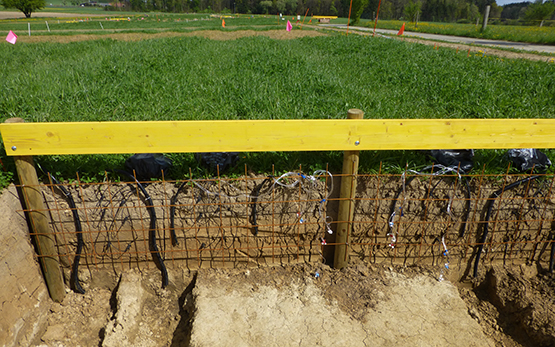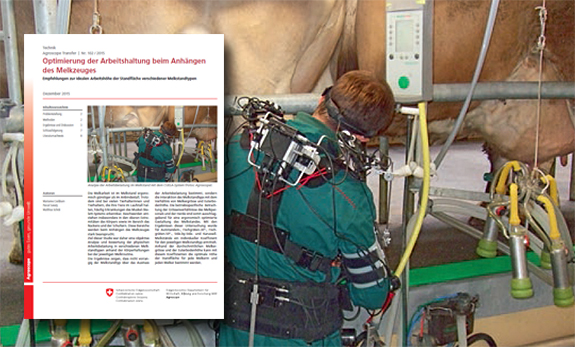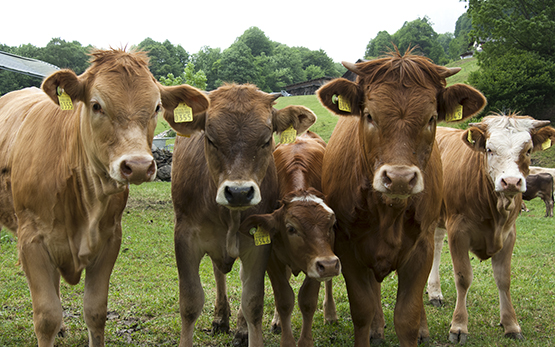Ammann J., Bär C., Bütikofer U., Vergères G., Wahl F., Walther B.
Wohin soll die Forschung gehen?
Ars Medici, 3, 2025, 124-126.
Bütikofer U., Blaser C., Kim C., Pimentel G., Fuchsmann P., Meng H., Marmonier C., Dardevet D., Polakof S., Vergères G.
Effect of dairy and fermented food diet on the urine metabolome of young and older men: A randomized controlled crossover intervention study.
In: PIMENTO 2nd Forum on Fermented Foods. 5 February, Hrsg. PIMENTO, Malaga (ES). 2025.
Stoffers H., Guggenbühl Gasser B., Nemati G., Purtschert G., Walther B., von Ah U.
Comparative fermentation of non-dairy milk alternatives using a newly developed vegan starter culture.
In: 38th EFFoST International Conference. 11 November, Hrsg. EFFoST, Burges (BE). 2024.
Vergères G., Bochud M., Jotterand Chaparro C., Moretti D., Pestoni G., Probst-Hensch N., Rezzi S., Rohrmann S., Brück W. M.
The future backbone of nutritional science: Integrating public health priorities with system-oriented precision nutrition.
British Journal of Nutrition, 132, (5), 2024, 651-666.
Todorovic S., Akpinar A., Assunção R., Bär C., Bavaro S. L., Berkel Kasikci M., Domínguez-Soberanes J., Capozzi V., Cotter P. D., Doo E.-H., Gündüz Ergün B., Guzel M., Harsa H. S., Hastaoglu E., Humblot C. und weitere
Health benefits and risks of fermented foods: The PIMENTO initiative.
Frontiers in Nutrition, 11, 2024, Artikel 1458536.
Pimentel G., Roder T., Bär C., Christensen S., Sattari Z., Kalbermatter C., von Ah U., Robert C. A. M., Mateo P., Bruggmann R., Ganal-Vonarburg S. C., Vergères G.
Maternal consumption of yoghurt activating the aryl hydrocarbon receptor increases group 3 innate lymphoid cells in murine offspring.
Microbiology Spectrum, 12, (12), 2024.
Walther B.
Milch – unentbehrlicher Teil der Diät?
In: Milchforum Swissmilk 2024. 10. Oktober, St. Gallen. 2024.
Tintrop L., Fuchsmann P.
Dynamic Headspace Vacuum In-Tube Extraction and GC‑MS for analyzing volatile compounds in various matrices.
In: 3rd European Sample Preparation Conference. 18 September, Hrsg. European Chemical Society (EuChemS), Chania (GR). 2024.
Pimentel G., Bär C., Vergères G., Fuchsmann P., Roder T., Von Ah U., Portmann R., Bütikofer U., Pimentel K. J., Leoni V.
Non-targeted mass spectrometry in agricultural research: Example of the identification of pollen species, and nutritional value of fermented food.
In: Ilmac Lausanne 2024 - «Latest Advances in Non-targeted Analysis». 18 September, Hrsg. Swiss Chemical Society, Lausanne. 2024.
Vergères G.
Inter‐individual variability in nutrient digestion.
In: 2024 Congress of the International Association pf Probiotics and Prebiotics. 9 July, Cork, Ireland, University College Cork. 2024, 1-24.
Pimentel G., Badertscher R., Blaser C., Noth P.
Validierte Methode zur Bestimmung von freien flüchtigen Carbonsäuren in Käse und Bakterienkulturen mittels GC-FID.
In: Cheese & Science. 11. Juni, Hrsg. Agroscope, Bern. 2024, 1-13.
Roder T., Pimentel G., Fuchsmann P., Tena Stern M., Von Ah U., Vergères G., Peischl S., Brynildsrud O., Bruggmann R., Bär C.
Scoary2: rapid association of phenotypic multi-omics data with microbial pan-genomes.
Genome Biology, 25, 2024, 1-19.
Bär C., Vergères G., Von Ah U., Pimentel G., Fuchsmann P., Blaser C., Macpherson A. J., Ganal-Vonarburg S. C., Sattari Z., Fernandez Trigo N., Bruggmann R., Roder T., Christensen S.
PolyFermentHealth-Projekt: Herstellung von funktionellen Lebensmitteln durch Fermentation.
In: Liebefelder Milchtagung. 28. November, Hrsg. Agroscope, Bern. 2023.
weitere Sprachen:
französisch
Walther B., Schmidt R.
Vitamin K in Käse.
In: Raclette Suisse Qualitätstagung. 4. Dezember, Zürich. 2023, 1-22.
Walther B., Pfenninger B.
EEK CFN FCN Update zum Positionspapier zu ultraverarbeiteten Lebensmitteln (UPF).
In: Forum 2023 zum Aktionsplan der Schweizer Ernährungsstrategie. 27. November, Bern. 2023, 1-22.
Badertscher R., Pimentel G., Blaser C., Noth P.
A simple, rapid and validated method for the determination of free volatile carboxylic acids in cheese by GC-FID.
Chimia, 77, (9), 2023, 622.
Bütikofer U., Blaser C., Kim C., Marmonier C., Dardevet D., Polakof S., Vergères G.
Effect of age and fermentation on postprandial serum and urine metabolites after consumption of milk and yogurt in healthy young and old men.
In: NuGOweek 2023. 5 September, Senigallia. 2023, 1.
Vergères G.
Bakterien erwünscht !
Lebensmittel-Industrie, 9, (10), 2023, 30-31.
Roder T., Pimentel G., Fuchsmann P., Tena Stern M., Von Ah U., Vergères G., Peischl S., Brynildsrud O., Bruggmann R., Bär C.
Scoary2: Rapid association of phenotypic large metabolomic datasets with the pan-genome of 44 Propionibacterium freudenreichii.
In: Agroscope Bioinformatics Symposium. 16 May, Hrsg. Agroscope, Zürich. 2023.
Vergères G., Bütikofer U.
Das gastrointestinale Mikrobiota (GIM) - ein Schlüsselelement zwischen Ernährung und Gesundheit.
Schweizer Zeitschrift für Ernährungsmedizin, 1, 2023, 17-20.
Wüthrich C., Fan Z., Vergères G., Wahl F., Zenobi R., Giannoukos S.
Analysis of volatile short-chain fatty acids in the gas phase using secondary electrospray ionization high-resolution mass spectrometry.
Analytical Methods, 15, (5), 2023, 553-561.
Yi Meng H., Kim J., Fleuti C., Fuchsmann P., Polakof S., Dardevet D., Marmonier Corinne, Pimentel K. J., Bütikofer U., Vergères G.
Age-dependent serum volatilomics of milk and yogurt intake: a randomized crossover study in healthy young and older men.
Journal of Proteome Research, 22, (4), 2023, 1201-1212.
Vergères G., Bütikofer U.
Die gastrointestinale Mikrobiota: Ein Schlüsselelement zwischen Ernährung und Gesundheit.
Schweizer Zeitschrift für Ernährungsmedizin, 1, 2023, 17-20.
Li K. J., Pimentel K. J., Brouwer-Brolsma E., Blaser C., Badertscher R., Pimentel G., Portmann R., Feskens E., Vergères G.
Identifying plasma and urinary biomarkers of fermented food intake and their associations with cardiometabolic health in a dutch observational cohort.
Journal of Agricultural and Food Chemistry, 71, (10), 2023, 4426-4439.
Segrestin B., Delage P., Nemeth A., Seyssel K., Disse E., Nazare J.-A., Lambert-Porcheron S., Meiller L., Sauvinet V., Chanon S., Simon C., Ratiney H., Beuf O., Pralong F., Yassin N.-a.-H. und weitere
Polyphenol supplementation did not affect insulin sensitivity and fat deposition during one-month overfeeding in randomized placebo-controlled trials in men and in women.
Frontiers in Nutrition, 9, 2022, 1-13.
Roder T., Oberhänsli S., Shani N., Bruggmann R.
OpenGenomeBrowser: a versatile, dataset-independent and scalable web platform for genome data management and comparative genomics: a versatile, dataset-independent and scalable web platform for genome data management and comparative genomics.
BMC Genomics, 23, (855), 2022, 1-11.
Guggisberg D., Pimentel K. J., Walther B., Badertscher R., Blaser C., Portmann R., Schmid A., Radtke T., Saner H., Fournier N., Bütikofer U., Vergères G.
Molecular effects of the consumption of margarine and butter varying in trans fat composition: A parallel human intervention study.
Lipids in Health and Disease, 21, 2022, 1-19.
Wüthrich C., de Figueiredo M., Pimentel K. J., Vergères G., Wahl F., Zenobi R., Giannoukos S.
Breath response following a nutritional challenge monitored by secondary electrospray ionization high-resolution mass spectrometry.
Journal of Breath Research, 16, (4), 2022, 1-12.
Bütikofer U., Badertscher R., Blaser C., Fuchsmann P., Tena Stern M., Kuert P. A., Pimentel G., Pimentel K. J., Vionnet N., Vergères G.
Serum and urine metabolites in healthy men after consumption of acidified milk and yogurt.
Nutrients, 14, (22), 2022, 1-23.
Walther B.
Jod in Milch und Käse.
In: SYMPOSIUM 100 Jahre Salzjodierung zur Vorbeugung von Jodmangel in der Schweiz. 22. September, 3003 Bern - BLV und Fluor und Jodkommission. 2022, 1-16.
Li K. J., Pimentel K. J., Brouwer-Brolsma E.M., Vergères G., Feskens E.J.M.
How can new personalized nutrition tools improve health?
Frontiers for Young Minds, 10, 2022, 1-8.
Roder T., Pimentel G., Bär C., Von Ah U., Bruggmann R., Vergères G.
Can eating bacteria from fermented foods support your health?
Frontiers for Young Minds, 10, 2022, 1-8.
Vergères G.
Sollen die Gene das Menü diktieren?
In: Treffpunkt Science City ETH Zurich. 13. März, ETH Zurich. 2022.
Wahl F.
Fostering nutrition research in Switzerland.
Bulletin VSH-AEU, 47, (1), 2021, 13-16.








